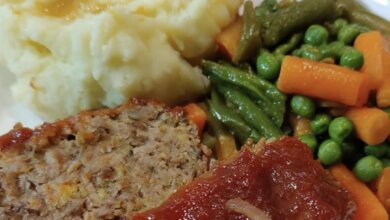Chinese Chicken Cabbage Stir-Fry Recipe

Introduction
Chinese Chicken Cabbage Stir-Fry is a delicious, quick, and nutritious dish that combines tender chicken strips with fresh, crisp cabbage, creating a harmonious blend of flavors and textures. This recipe is perfect for a busy weeknight as it can be prepared in under 20 minutes. The use of soy sauce, oyster sauce, garlic, and ginger infuses the dish with savory, earthy, and slightly sweet notes that complement each other beautifully. Known for being both satisfying and nutritious, this dish is a staple in many Chinese households and is loved worldwide.
Ingredients
- 1 lb boneless chicken breast, sliced into thin strips
- 1 small Chinese cabbage, chopped into bite-sized pieces
- 2 cloves of garlic, minced
- 1 inch ginger, peeled and grated
- 2 tbsp vegetable oil
- 2 tbsp soy sauce
- 1 tbsp oyster sauce
- 1 tsp cornstarch
- 1/4 cup water
- Salt and pepper, to taste
Instructions
- In a small bowl, mix together soy sauce, oyster sauce, cornstarch, and water. Set aside.
- Heat vegetable oil in a wok over high heat. Add garlic and ginger and stir-fry for 30 seconds until fragrant.
- Add chicken strips and cook for 2-3 minutes until browned.
- Add Chinese cabbage and continue stir-frying for another 2-3 minutes until the cabbage is wilted but still slightly crunchy.
- Pour in the sauce mixture and stir-fry for another minute until the sauce thickens and coats the chicken and cabbage evenly.
- Season with salt and pepper to taste, and serve hot with rice.
History
Stir-frying originated in China over 2,000 years ago and is still one of the most popular cooking techniques in Chinese cuisine today. This method is characterized by cooking ingredients quickly over high heat, preserving their natural flavors, textures, and nutrients. The combination of chicken and cabbage in stir-fry is widely loved because it offers a balanced mix of protein and fiber, along with a satisfying crunch from the cabbage. As Chinese cuisine spread globally, dishes like chicken and cabbage stir-fry became beloved by people worldwide, adapting slightly to different cultures while maintaining the essence of traditional Chinese cooking.
Benefits
This Chinese Chicken Cabbage Stir-Fry offers numerous health benefits:
- Protein: Chicken is a lean protein that aids in muscle growth and tissue repair.
- Fiber and Vitamins: Chinese cabbage is rich in fiber, vitamins C and K, and antioxidants, which are essential for immune function and skin health.
- Low in Calories: This recipe is relatively low in calories, making it an ideal choice for those looking to maintain or lose weight.
- Healthy Fats: The dish uses minimal oil, making it heart-friendly and suitable for low-fat diets.
Preparation and Cooking Techniques
This recipe follows the stir-fry method, a cornerstone of Chinese cooking. Here are some key techniques used:
- High Heat Cooking: This method retains nutrients and creates the signature smoky “wok hei” flavor in the food.
- Quick Stirring: Constantly stirring the ingredients prevents burning and ensures even cooking.
- Marinating with Cornstarch: Adding cornstarch to the sauce gives the dish a smooth, glossy finish and thickens the sauce.
Nutrition Information (Per Serving)
- Calories: Approximately 250
- Protein: 25g
- Carbohydrates: 10g
- Fat: 10g
- Fiber: 3g
- Vitamin C: 40% of daily value
- Iron: 15% of daily value
Conclusion
Chinese Chicken Cabbage Stir-Fry is a flavorful, balanced, and satisfying meal that suits various dietary preferences. Its simplicity, quick preparation, and nutritional profile make it an ideal choice for both beginner and seasoned cooks. With its authentic Chinese flavors and wholesome ingredients, this stir-fry dish has become a favorite for health-conscious individuals and food lovers alike.
For Stir-Fry Lovers
Chinese stir-fry dishes like this one appeal to those who enjoy robust flavors and a balance of protein, vegetables, and sauce. Lovers of quick, healthy, and delicious meals often find this dish perfect for busy lifestyles and appreciate its versatility, as it can easily be modified by adding different vegetables or using different proteins.



